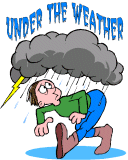
Introduction to Weather
 Weather is what is happening in the atmosphere at any time or short period of time. Weather conditions can change suddenly. Today may be warm and sunny, tomorrow may be cool and cloudy. Weather conditions include clouds, rain, snow, sleet, hail, fog, mist, sunshine, wind, temperature and thunderstorms.
Weather is what is happening in the atmosphere at any time or short period of time. Weather conditions can change suddenly. Today may be warm and sunny, tomorrow may be cool and cloudy. Weather conditions include clouds, rain, snow, sleet, hail, fog, mist, sunshine, wind, temperature and thunderstorms.
Weather is driven by the heat stored in the Earth's atmosphere, which comes from energy from the Sun. When heat is moved around the Earth's surface and in the atmosphere because of differences in temperature between places, this makes winds. Winds form part of larger weather systems, the most powerful of which is the hurricane. Other weather features like the thunderstorm also develop because of the movement of heat in the atmosphere. Some thunderstorms in the United States give birth to tornadoes.
Like energy, water is moved between the Earth and the atmosphere. The Earth's water cycle plays an important role in the development of many weather features like dew, fog, clouds and rain.
Scientists measure the weather so they can forecast it. This involves plotting weather information on special charts. Weather radar and satellites are now also used to help predict the weather.
Websites
Other topics Technical Page
Technical Page
• ARIC
• Met. Office
• BBC Weather
• Wild Weather Page
• 4 Seasons Project
• Environmental Change Network
• Weather Dude
• Weather World
• Chain Reaction
• Franklin Institute
• Infoplease.Com
• Weather Station
• Weather Gone Wild
• Weather Terms
• Introduction to Weather
• Clouds
• Dew
• Energy
• Fog
• Forecasting
• Hurricanes
• Measuring Weather
• Thunderstorms
• Tornadoes
• Water Cycle
 Print Topic
Print Topic